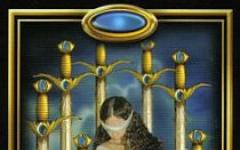In this article we will tell you what processes in the body lead to the end of life and how death occurs. Have you thought about this? After reading, you can leave your opinion on this topic, your comment at the end of the article.
For many of us, death is a process that we can only see on TV and in movies. On screen, characters die, and then we see the actors who played their roles in full health.
Death constantly accompanies various news. Celebrities die from overdoses, road accidents, ordinary people die from accidents and terrorist attacks.
What is death?
IN different times death was defined in different ways. Most often, they said that this is the separation of bodies. However, almost everyone is talking about this. But from a purely biological point of view, death is still difficult to define. Only recently created medical equipment can help understand whether a person is alive or dead.
This didn't happen before. If a person was sick, a doctor or priest was called to him, who pronounced death. Approximately. That is, if a person does not move and does not seem to breathe, he is dead. How was it determined that a person was not breathing? A mirror or feather was brought to his mouth. If the mirror fogged up and the pen moved from breathing, the person was alive; if not, he was dead. In the 18th century, they began to check the pulse on the hand, but the invention of the stethoscope was still far away.
Over time, people realized that, despite the absence of breathing and heartbeat, a person can be alive. Edgar Poe alone wrote several stories about those buried alive. In general, it turned out that it can be reversible.
Today we know that there is a device that can bring a person back to life. If a person stops breathing, but his heart is still beating, a defibrillator can be used to stimulate his activity.
True, the presence of a pulse does not mean that a person is alive. Both doctors and relatives of the dying understood this. If the brain is dead, and cardiac activity is supported by machines in intensive care, then the person is more likely dead than alive. In medical parlance, this is called an irreversible coma.
It is, of course, difficult for the relatives of a dying person to recognize such a death. They are told that a person has died while he is breathing and his body is radiating heat. At the same time, the machines record minimal brain activity, and this gives relatives false hope that the patient will recover. But brain activity alone is not enough for life.

Although death is considered brain death, rarely will you see this finding listed as the official cause of death. More often you can see such as “myocardial infarction”, “cancer” and “stroke”. In general, death is caused in three different ways:
- as a result of severe bodily injuries received in automobile and other man-made accidents, falls and drownings;
- as a result of murder and suicide;
- as a result of illness and wear and tear of the body during old age.
In the old days, people rarely lived to old age, dying prematurely from disease. These days, many fatal diseases have been eliminated. Of course, there are still areas on Earth with undeveloped medicine, where people die mainly from AIDS.
In countries with high incomes, death is more likely to occur from coronary disease heart disease, stroke, lung cancer, lower respiratory tract infections and pulmonary failure. At the same time, in countries with high incomes, life expectancy is longer. True, people more often suffer from degenerative diseases.
How Death Occurs - The Process
If the brain dies first in the body, the person stops breathing. Cells that do not receive oxygen begin to die.

Different cells die with at different speeds. It depends on how long they go without oxygen. The brain requires a lot of oxygen, so when the air flow stops, brain cells die within 3-7 minutes. This is why stroke kills patients so quickly.
During a myocardial infarction, blood flow is disrupted. The brain also stops receiving oxygen, and death may occur.
If a person is not sick with anything, but lives for a very long time, his body simply wears out from old age. His functions gradually fade away and he dies.
There are some external manifestations of decrepitude of the body. A person begins to sleep more so as not to waste energy. Once a person loses the desire to move, he loses the desire to eat and drink. He has a dry throat, it becomes difficult for him to swallow anything, and drinking liquids can cause choking.
Shortly before death, a person loses the ability to control discharge from Bladder and intestines. However, he hardly urinates anymore and doesn’t walk very much, because he practically doesn’t eat, and he gastrointestinal tract stops functioning.
If a person experiences pain before dying, doctors can provide relief.
Shortly before death, a person begins to experience agony. The dying person is disoriented and finds it difficult to breathe. He breathes loudly and heavily. If there is an accumulation of fluid in the lungs, the patient may experience a death rattle. Due to the disruption of communication between the cells of the body, the dying person begins to experience convulsions and muscle spasms.
We cannot know exactly what a person experiences on the eve of death. But those who died, but were saved in time, argued that death did not hurt. At the same time, all the dying people experienced a feeling of detachment and peace; they felt that their soul was being separated from physical body, they had the feeling that they were moving from darkness to light. In general, hundreds of books and works have already been written about this.

Some doctors argue that near-death experiences are due to the fact that before death, endorphins are released in the human body - pleasure hormones.
When the heartbeat and breathing stop, clinical death occurs. Oxygen does not enter the cells, there is no blood circulation. However, clinical death is a reversible condition. With the help of modern means of resuscitation, such as blood transfusion or artificial ventilation, a person can still be brought back to life.
The point of no return is biological death. It begins 4-6 minutes after the clinical one. Once the pulse stops, brain cells begin to die from lack of oxygen. Now resuscitation no longer makes sense.
What happens to the body after death?
After the heart stops beating, the body cools down and rigor mortis begins. Every hour, body temperature drops by almost a degree. This continues until the body temperature reaches room temperature. In the absence of movement, the blood begins to stagnate, and cadaveric spots appear. This occurs within the next 2-6 hours after death.
Even though the body has died, some processes still continue in the body. Skin cells, for example, function within 24 hours of death.
A few days after death, the bacteria and enzymes contained in it are taken to destroy the body. The pancreas has so many bacteria that it begins to digest itself. As microorganisms work on the body, it becomes discolored, first becoming greenish, then purple and finally black.
If you do not visually notice changes in the body, then you cannot help but notice the smell. Bacteria destroying the body produce a foul-smelling gas. Gas is not only present in the room in the form of an unpleasant odor. It swells the body, making the eyes bulge and protrude from their sockets, and the tongue so thick that it begins to protrude from the mouth.
A week after death, the skin becomes covered with blisters, and the slightest touch to it can lead to their spontaneous opening. Nails and hair continue to grow for a month after death.
But this is not because they are actually growing. The skin just dries out and they become more noticeable. Internal organs and the tissues fill with fluid and swell. This will continue until the body bursts. After this, the insides dry out, and only a skeleton remains.
Most of us cannot witness the entire process described above, because the laws of different countries force citizens to do something with the body. The body can be placed in a coffin and buried in the ground. It can be frozen, embalmed or cremated. And for the same reason, we did not place images in this part of the text. Even if they exist, you shouldn’t look at them - the picture is not for the faint of heart.
Funerals in different countries and among different peoples
In ancient times, people were buried so that they would awaken in the afterlife. For this purpose, their favorite things, and sometimes their favorite animals and even people, were placed in their tombs. Warriors were sometimes buried in an upright position so that they would be ready for battle in the afterlife.

Orthodox Jews wrapped their dead in a shroud and buried them on the day of death. But Buddhists believe that consciousness remains in the body for three days, so they bury the body no earlier than this period.
Hindus cremated the body, freeing the soul from the body, while Catholics have an extremely negative attitude towards cremation, believing that it insults the body as a symbol of human life.
Death and medical ethics
We have already written about the difficulties in determining the occurrence of death. Thanks to modern medical technology, it has become possible to keep the body alive even after brain death. When the brain dies, this is documented and communicated to the relatives of the deceased.
Then there are two possible scenarios. Some relatives agree with the doctors’ opinion and give permission to disconnect the deceased from life support machines. Others do not recognize death, and the deceased continues to lie under the apparatus.
People would like to always be in control of their lives, but death deprives them of this. Now their fate will be determined by the doctor, whose decision will determine whether to disconnect the deceased from the devices or not.
In general, a person whose brain does not work can no longer live fully. He cannot make decisions and benefit both his relatives and society. Relatives of the deceased must understand this and come to terms with the loss of a family member.
Appreciate your loved ones while they are with you, and let them go if they have already left.
What happens to a person after death is one of the main questions we ask ourselves during life. A great variety of versions and theories have accumulated, from theological to esoteric. What are the main approaches to the afterlife that humanity has created during its existence...
In the article:
What happens to a person after death
The main reason for this curiosity is simple and clear. Everyone has a fear of what awaits beyond the last threshold. We exist under the constant pressure of the knowledge that life will end. This is made worse by the fact that no one will give a definite answer. Yes, there are many explanations, but which one is correct...
 Everyone will answer this question themselves. It is a matter of personal choice what to believe. Most of these theories seem plausible. And there is an opinion that each of them is accurate in its own way. Which belief to turn to, which doctrine to choose: the text below will not answer. But he will talk about the basic things that humanity has come to in its history.
Everyone will answer this question themselves. It is a matter of personal choice what to believe. Most of these theories seem plausible. And there is an opinion that each of them is accurate in its own way. Which belief to turn to, which doctrine to choose: the text below will not answer. But he will talk about the basic things that humanity has come to in its history.
But the only thing researchers say for sure is that. Although the very concept "life after death" does not work always and not everywhere. Not all religions or teachings talk about rebirth and a new beginning. The predominant part of them talks about how another existence will await us beyond the final threshold. Not life in our usual understanding, but also rebirth, but spiritual. So decide which interpretation of this phrase to use.
How researchers found out what happens to a person’s soul after death... These thoughts began with ordinary logic, nothing disappears. The plant dies, rots, falls into the soil and becomes a part from which new flowers then appear. But this cannot be the case with the soul.
And science tells us by the law of conservation of energy that if there is such a thing, then it cannot simply dissolve. She moves on to another object, the atom. The soul is not energy, but a light that helps to become a person. It allows you to create masterpieces of art and colossal structures. How else can we explain those impulses that drive us to strange actions? Not all of them fit the concept of instinct.
So many people have a question - what awaits a person after death, to believe that there will be nothing, eternal darkness, is impossible. It does not fit into the framework of ordinary logic and scientifically confirmed facts. For example, the fact that after death a person’s body becomes lighter by tens of grams. This cannot be explained by the usual drying of tissues; not even a minute passes after death.
 Another fact is that the deceased ceases to look like himself in life. The dead are different from who they were when they were alive. You might think it's a different person. This cannot be explained by banal muscle sagging, because everyone sees the changes. Something is missing. We look at a dead person and cannot find what was in him during life. So the brain tells us that everything, there is no soul in this body.
Another fact is that the deceased ceases to look like himself in life. The dead are different from who they were when they were alive. You might think it's a different person. This cannot be explained by banal muscle sagging, because everyone sees the changes. Something is missing. We look at a dead person and cannot find what was in him during life. So the brain tells us that everything, there is no soul in this body.
Don't forget about those psychics who talk to dead people. Yes, among such practitioners there are charlatans, but as in any activity that has gained popularity. There are unreliable scientists who do what they pass off as real science. But there are those who speak with the dead, and a caste of people who can do this. When communicating with the relatives of the deceased, they reveal facts that make your hair stand on end. How he comprehended this, and how he received such information, which was in the hands of the deceased. This is another confirmation that life after death exists. Talented people can communicate directly with the dead.
Many skeptics will exclaim - how can we trust in something like this if we cannot touch it with our hands? How to believe in something so ephemeral. We rely on any achievements of science. Most of them are understandable to professionals or specialists. The energies they operate are invisible to the ordinary eye - many devices are needed. But we believe, although we do not see and do not understand.
There is no device that could register the movement of the soul. Ancient philosophical assumptions turned out to be correct. The atomic structure of substances, gravity and much more that the great philosophers of antiquity came up with were scientifically confirmed in the future. And the discussion about the soul turns out to be just like this the most ancient teaching. Modern science has no way to test it. But someday...
What happens to the soul after death in different religions
 All the versions that have appeared among humanity over the entire period of existence are strangely similar, which leads to reflection. There are similar and identical points. There is eternal bliss, lifelong torment, sinners and righteous people (with a footnote to cultural differences). Such cross-similarity shows that with a high degree of probability there is a particle of truth here. And around the grain, as folk wisdom says, pearls appear.
All the versions that have appeared among humanity over the entire period of existence are strangely similar, which leads to reflection. There are similar and identical points. There is eternal bliss, lifelong torment, sinners and righteous people (with a footnote to cultural differences). Such cross-similarity shows that with a high degree of probability there is a particle of truth here. And around the grain, as folk wisdom says, pearls appear.
What happens to the soul after death in different beliefs and traditions:
- Christianity. The concept of heaven - Kingdom of heaven. In the minds of Christians, this is precisely the kingdom. , in Heaven there is something resembling an infrastructure, hierarchy and control system. Everything is calm, beautiful and orderly. People, if they are worthy to get here, are in eternal bliss and do not need anything.
- Judaism. There is no whole concept of a place where a person goes after death. The only thing is that it doesn’t look like our usual existence:
In the future world there is no food, no drink, no reproduction, no trade, no envy, no enmity, no competition, but the righteous sit with crowns on their heads and enjoy the radiance of the Divine. (Talmud, Berachot 17a).

As soon as they enter the water, it rises in accordance with their desires: ankle-deep, knee-deep, waist-deep or throat-deep. If someone wants the water to be cold, it will be cold, if someone else wants the water to be hot, for him it will become hot, if they want it to be both hot and cold, for them it will become both hot and cold, in order to please them, etc. (Great Sukhavativyuha).
But this is an impermanent place of existence where a person cannot develop. It looks like a stop, a point where you rest before moving on. And then, having exhausted all good memories, a person is reborn in an earthly body.
This is what awaits the righteous. But how did the ancients distinguish one from the other: for this, in every culture there were many different places where a person was assessed by his deeds or condemned. Court. What it was like in different cultures.

Chinwat. Bridge leading over the abyss
This is a list of humanity's ideas about the afterlife, notable pieces of it. It is presented to show the similarities and differences between each of the traditions. Some of them are simpler, some are complex. There are down-to-earth people who say that after death earthly pleasures await us. But that's not the point.
The point is that they are all similar in certain ways. By comparing them, we can build a separate understanding of what happens to the soul after death. All of the above traditions say that after death there is a judgment. It is impossible to say exactly which of them is right - we will rely on general facts. It is impossible to say what it will look like and what actions will begin to be weighed. What is clear is that this will happen.
Each culture invented an afterlife for itself, relying on the things that surrounded them in everyday life. Take a look at Nordic tradition. This means that in our imagination we operate with those facts that are familiar to us. As a result, the Judgment that awaits will be nothing like what is described above. There will be things that we simply don’t have enough imagination for. What exists there is not based on our world, which means it will look its own.
After the trial we will go to another world. Many practitioners say that to another world - to one of the parallel ones. And it is true. But if so, then how do psychics know how to communicate with the souls of the dead... There is a theory that claims that the souls with whom such figures talk are simply a reflection of a person in the real world. A piece of memory, a cast of character, or its imprint on the material world. During our lives, we imperceptibly change the objects around us, bend the information field, which is fueled by our actions, actions, or thoughts. This reflection is seen by those who talk to the dead. Not the person himself, but part of the memory that he left here after moving to another world.
The fate of a person’s soul after death - can it get stuck in this world?
Under certain circumstances, a person's soul after death can get lost in the many paths that open before him. And don't follow any of them. Why does this happen: no one is able to answer this, the topic has not been studied. But one thing is clear - if you stay here, the soul will begin to suffer.
 And it's not so scary when she really stays on the material plane. And what will happen if she gets lost is scary to imagine. Such a lost soul is doomed to eternal suffering on such a scale that no priest who tells us about the torment of sinners can even imagine. Moreover, they can be experienced by a person who was an ardent righteous person during his lifetime. But first things first.
And it's not so scary when she really stays on the material plane. And what will happen if she gets lost is scary to imagine. Such a lost soul is doomed to eternal suffering on such a scale that no priest who tells us about the torment of sinners can even imagine. Moreover, they can be experienced by a person who was an ardent righteous person during his lifetime. But first things first.
When a person dies, what happens to the soul: she separates from the body for several days and moves to the spiritual plane. Or, to use church language, soars upward. The soul spends some time trying to decide what next, what to do and where to go. And he moves on to the next plane, beginning his difficult journey through the ephemeral, invisible world. But what happens to the soul after death, when during life a person was indecisive and lethargic... It retains all the qualities that a person possesses.
Biological (true) death of a person is a complete stop of all life-supporting processes. Death is an irreversible phenomenon. Not a single person can bypass it. This process is characterized by its pre-mortem and post-mortem signs - a decrease in body temperature, rigor mortis, etc.
Where does a person's soul go after his physical death?
According to the beliefs of the ancients, the afterlife of any person is the very stage in his existence. They believed that earthly life is not as important as the afterlife. The ancient Egyptians seriously believed that the other world was new life, which is a kind of equivalent of earthly existence, only without wars, food, water and disasters.
They also spoke interestingly about the human soul. They believed that for the continued existence of all its 9 elements, some kind of material connection was needed. That's why in Ancient Egypt They were so careful about embalming and preserving the body. This was the impetus for the construction of pyramids and the appearance of underground crypts.
Some Eastern religions have teachings about the reincarnation of the soul. It is believed that she does not go into the other world, but is reborn anew, taking over a new personality that does not remember anything about her previous life.
The ancient Romans and Greeks generally believed that the soul of a person after his death went to the underground kingdom of Hades. To do this, the soul had to cross the river called Styx. She was helped in this by Charon, a ferryman who transports souls on his boat from one shore to the other.
In addition, in such legends it was believed that a person who, during his life, had earned special favor from the gods, sat on Mount Olympus.
Heaven and Hell. "Gap" in science
In Orthodoxy it is believed that good and good man goes to heaven, and the sinner goes to hell. Today scientists are trying to find a reasonable explanation for this. In this they are helped by people who have returned from the “other world”, i.e. survivors of clinical death.
Doctors explained the phenomenon of “light at the end of the tunnel” by linking similar sensations of a person experiencing clinical death with the limited transmission of a light beam into his pupil.
Some of them claim to have seen hell with their own eyes: they were surrounded by demons, snakes and a nasty stench. “Natives” from “paradise,” on the contrary, divide pleasant impressions: blissful light, lightness and fragrance.
However, neither confirm nor refute this evidence modern science can't yet. Each person, each religion and teaching has its own guesses and has its own views on this matter.
After a loved one passes away, our consciousness does not want to accept the fact that he is no longer around. I would like to believe that somewhere far away in heaven he remembers us and can send a message.
In this article
The connection between the soul and a living person
Followers of religious and esoteric teachings consider it as a small particle of Divine consciousness. On Earth the soul manifests itself through best qualities person: kindness, honesty, nobility, generosity, ability to forgive. Creative abilities are considered a gift from God, which means they are also realized through the soul.
She is immortal, but the human body has a limited lifespan. Therefore, the soul leaves the body and goes to another level of the universe.
Basic theories about afterlife
Myths and religious views of peoples offer their vision of what happens to a person after death. For example, the “Tibetan Book of the Dead” describes step by step all the stages through which the soul passes from the moment of dying to the next incarnation on Earth.
Heaven and Hell, Heavenly Court
In Judaism, Christianity and Islam, a Heavenly court in which one's earthly deeds are judged. Depending on the number of mistakes and good deeds, God, angels or apostles divide dead people into sinners and righteous people in order to send them either to Heaven for eternal bliss or to hell for eternal torment.
However, the ancient Greeks had something similar, where all the dead were sent to the underground kingdom of Hades under the guardianship of Cerberus. Souls were also distributed according to their level of righteousness. Pious people were placed in Elysium, and vicious people were placed in Tartarus.
The judgment of souls is present in different variations in ancient myths. In particular, the Egyptians had a deity, Anubis, who weighed the heart of the deceased with an ostrich feather to measure the severity of his sins. Pure souls headed to the paradise fields of the solar god Ra, where the rest were not allowed to go.
The souls of the righteous go to heaven
Evolution of the soul, Karma, Reincarnation
Religions ancient india look at the fate of the soul differently. According to traditions, she comes to Earth more than once and each time she gains invaluable experience necessary for spiritual evolution.
The souls of loved ones who passed away earlier appear nearby. They look like living substances emitting light, but the traveler knows exactly who he has met. These essences help to move on to the next stage, where the Angel awaits - a guide to the higher spheres.

The path the soul follows is illuminated by Light
People find it difficult to describe the image of the Divine being on the path of the soul in words. This is the embodiment of Love and a sincere desire to help. According to one version, this is a Guardian Angel. According to another, he is the progenitor of all human souls. The guide communicates with the newcomer using telepathy, without words, in the ancient language of images. He demonstrates the events and misdeeds of his past life, but without the slightest hint of condemnation.
The road passes through space filled with Light. Those who have experienced clinical death talk about the feeling of an invisible barrier, which probably serves as the border between the world of the living and the kingdom of the dead. None of those who returned comprehended beyond the veil. What lies beyond the line is not given to the living to know.
Can the soul of the deceased come to visit?
The religion condemns the practice of spiritualism. This is considered a sin, since a tempting demon may appear under the guise of a deceased relative. Serious esotericists also do not approve of such sessions, since at this moment a portal opens through which dark entities can penetrate into our world.

The Church condemns seances for communicating with the dead
However, such visits can occur on the initiative of those who left Earth. If there was a strong connection between people in earthly life, then death will not break it. For at least 40 days, the soul of the deceased can visit relatives and friends and observe them from the side. People with high sensitivity sense this presence.
Russian biologist Vasily Lepeshkin
In the 1930s, a Russian biochemist discovered energy emissions emanating from a dying body. The bursts were recorded on ultra-sensitive photographic film. Based on observations, the scientist came to the conclusion that a special substance is separated from the dying body, which in religions is usually called the soul.
Professor Konstantin Korotkov
Doctor of Technical Sciences has developed a method of gas discharge visualization (GDV), which makes it possible to record fine-material radiation from the human body and obtain an image of the aura in real time.
Using the GDV method, the professor recorded energy processes at the moment of death. In fact, Korotkov’s experiments gave a picture of how a subtle component emerges from a dying person. The scientist believes that then consciousness, together with the subtle body, goes to another dimension.
Physicists Michael Scott from Edinburgh and Fred Alan Wolf from California
Adherents of the theory of many parallel Universes. Some of their options coincide with reality, others radically differ from it.
Any living being (more precisely, its spiritual center) never dies. It is simultaneously embodied in different versions of reality, and each individual part is unaware of its counterparts from parallel worlds.
Professor Robert Lantz
He drew an analogy between the continuous existence of humans and the life cycles of plants, which die in the winter, but begin to grow again in the spring. Thus, Lanz’s views are close to the Eastern doctrine of personal reincarnation.
The professor admits the existence of parallel worlds in which the same soul lives at the same time.
Anesthesiologist Stuart Hameroff
Due to the specifics of my work, I observed people on the verge of life and death. Now he is sure that the soul has a quantum nature. Stewart believes that it is not formed by neurons, but by the unique substance of the Universe. After the death of the physical body, spiritual information about the personality is transmitted into space and lives there as free consciousness.
Conclusion
As you can see, neither religion nor modern science denies. Scientists, by the way, even named its exact weight - 21 grams. Having left this world, the soul continues to live in another dimension.
However, while remaining on Earth, we cannot voluntarily make contact with departed relatives. We can only keep good memories of them and believe that they also remember us.
A little about the author:
Evgeniy Tukubaev The right words and your faith are the key to success in the perfect ritual. I will provide you with information, but its implementation directly depends on you. But don’t worry, a little practice and you will succeed! Copper bracelet for health and protection from dark forces: myth or reality?Image copyright Getty
The light at the end of the tunnel is a popular idea of how we experience the transition to another world. But as BBC Future correspondent Rachel Newwer says, the experiences of people who have experienced clinical death are much more varied.
The experience of people who have experienced clinical death refutes the popular idea of our sensations on the verge of life and death
In 2011, a 57-year-old social worker from England - let's call him Mr A - was rushed to Southampton General Hospital after collapsing at work. While doctors were trying to insert a catheter into the patient, his heart stopped. Without access to oxygen, the brain instantly stopped functioning. Mr. A. died.
Despite this, he remembers what happened next. The doctors took an automated external defibrillator (AED), a machine that activates the heart using an electric shock. Mr. A. heard the mechanical voice repeat twice: “Discharge.” Between these two commands, he opened his eyes and saw a strange woman in the corner under the ceiling, who beckoned him with her hand.
Image copyright Thinkstock Image caption The light at the end of the tunnel is just one of many scenarios for feeling dead“She seemed to know me, I felt trust in her, I thought she was there for a reason, but I didn’t know what it was,” Mr. A. later recalled. “The next second I was already upstairs, looking down at himself, a nurse and some bald man."
Researchers believe that collecting objective scientific data about potentially the last moments of life is quite possible. Over the course of four years, they analyzed more than 2,000 patients who experienced cardiac arrest, that is, official clinical death.
Image copyright Thinkstock Image caption It felt like I was being pulled deep underwaterOf this group of patients, doctors were able to bring 16% back to life. Dr. Parnia and his colleagues interviewed a third of these patients—101 people. "Our goal is to first understand what people feel at the time of death," says Dr. Parnia. "And then prove that what patients say they see and hear at the moment of death is actually an awareness of reality."
Seven Shades of Death
Mr. A is not the only patient who has had flashbacks to his death. Almost 50% of study participants could remember something. But unlike Mr. A and another woman, whose account of being outside her own body could not be objectively proven, the experiences of the other patients did not seem to be tied to actual events that took place at the time of their death.
Their stories were more like dreams or hallucinations, which Dr. Parnia and his colleagues divided into seven main scenarios. "Most of them did not correspond to what used to be called 'near-death' experiences," says Parnia. "It appears that there is much more to the psychological experience of death than we have realized in the past."
These seven scenarios include:
- Fear
- Images of animals or plants
- Bright light
- Violence and Harassment
- Deja vu or the feeling of "already seen"
- Faces of family members
- Memories of events after cardiac arrest
The mental experiences of patients range from terrible to blissful. Some patients report feelings of overwhelming terror or persecution. For example, like this. “I had to go through a burning ceremony,” recalls one study participant. “There were four people with me, and if one of them lied, he had to die... I saw people in coffins who were buried in an upright position.”
Another person recalls being “dragged deep under water,” and another patient says that “they told me I was going to die and the most quick way to do this is to say the last short word that I don’t remember.”
However, other respondents report quite the opposite feelings. 22% recall a “feeling of peace and tranquility.” Some saw living creatures: “There is everything and everyone around, in plants, but not flowers” or “lions and tigers.” Others basked in the "bright light" or were reunited with family. Some had a strong sense of déjà vu: “I felt like I knew exactly what people were going to do and they were actually doing it.” Heightened senses, a distorted sense of time, and a feeling of separation from one's own body are common memories of near-death survivors.
Image copyright Thinkstock Image caption Some patients felt that they were separated from their own bodyWhile "certainly people felt something at the time of death," says Professor Parnia, how they interpreted those experiences depended entirely on their experiences and beliefs. Hindus could say that they saw Krishna, and a resident of the US Midwest claimed that he saw God. “If a person who is raised in Western society is told that when you die you will see Jesus Christ and he will be full of love and compassion, then of course she will see him,” the professor says. “She will come back and say: 'Father, you're right, I really saw Jesus!" But how can any of us recognize Jesus or any other God? You don't know what God is like. I don't know what he is like. Except for pictures of a man with a white beard, although everyone understands that This is a fabulous show."
“All this talk about the soul, heaven and hell - I have no idea what they mean. There are probably thousands of interpretations, depending on where you were born and how you were raised,” says the scientist. “It is important to move these memories from the field of religion into the plane of reality."
Common Cases
So far, the team of scientists has not established what will determine the ability of patients to remember their feelings at the moment of death. There is also a lack of explanations about why some people experience scary scenarios while others report euphoria. Dr. Parnia also notes that apparently more people have near-death memories than statistics indicate. Most people lose these memories due to severe brain swelling caused by cardiac arrest or the heavy sedatives they are given in intensive care.
Even if people cannot remember their thoughts and feelings at the time of death, the experience will undoubtedly affect them on a subconscious level. The scientist suggests that this explains the very opposite reaction of patients who returned to life after cardiac arrest. Some people no longer fear death at all and begin to approach life more altruistically, while others develop post-traumatic stress disorder.
Image copyright Thinkstock Image caption Some patients find themselves in terrible places, others see GodProfessor Parnia and his colleagues are planning further research to find answers to these questions. They also hope that their work will help shed new light on ideas about death and free it from stereotypes associated with religion or skepticism.
Death may well be an object of scientific study. “Any person with an objective mind will agree that research must be continued,” says the scientist. “We have the capabilities and technologies. Now is the time to do this.”









